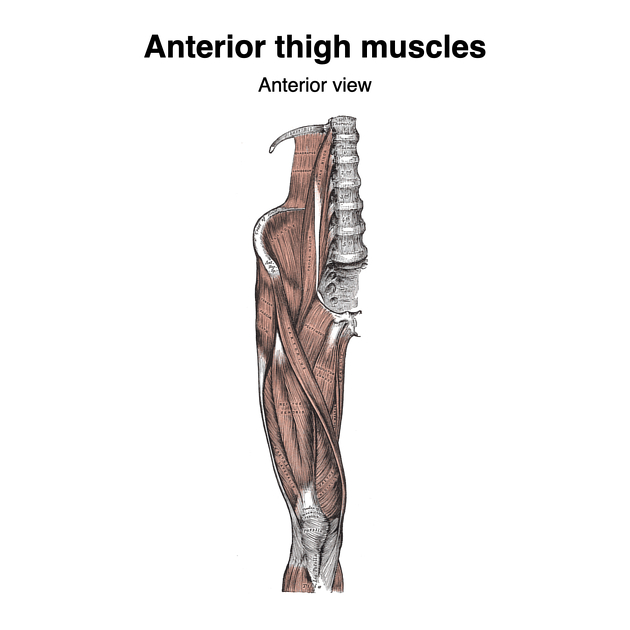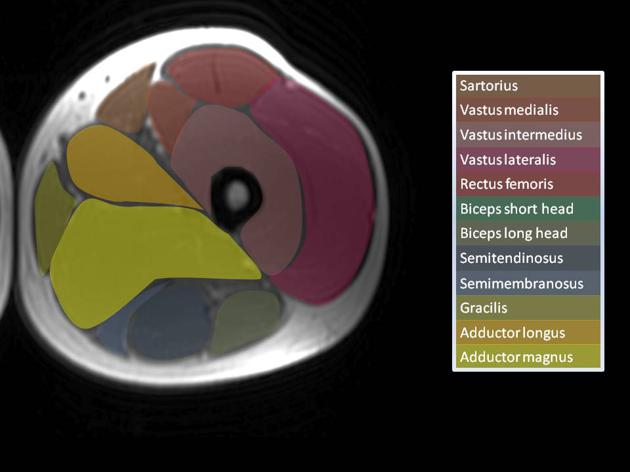Vastus lateralis muscle
Citation, DOI, disclosures and article data
At the time the article was created a b had no recorded disclosures.
View a b's current disclosuresAt the time the article was last revised Henry Knipe had the following disclosures:
- Micro-X Ltd, Shareholder (past)
These were assessed during peer review and were determined to not be relevant to the changes that were made.
View Henry Knipe's current disclosures- Vastus lateralis (VL)
The vastus lateralis is the largest of the four quadriceps muscles in the anterior compartment of the thigh.
On this page:
Summary
origin: proximal femur
-
insertion
lateral margin of the patella
action: extends the leg at the knee joint
arterial supply: lateral circumflex femoral and deep femoral arteries
innervation: femoral nerve (L2-L4)
Gross anatomy
Relations
The vastus lateralis muscle lies superficial to the biceps femoris muscle, with its lateral side covered by the tensor fasciae lata. The muscle lies medial to the gluteus maximus and lateral to the vastus intermedius muscle 1-3.
Origin
The vastus lateralis originates from the femur at the anterior inferior greater trochanter, upper part of the intertrochanteric line, superior aspect of the lateral lip of the linea aspera and lateral lip of the gluteal tuberosity 1-4.
Insertion
Along with other muscles of the quadriceps femoris, the vastus lateralis inserts on the tibial tuberosity via the patellar ligament. Also, it attaches to the lateral aspect of the patella 1-3.
ADVERTISEMENT: Supporters see fewer/no ads
Action
The vastus lateralis provides the extension of the leg at the knee joint 1-3.
Innervation
The vastus lateralis is innervated by the muscular branches of the femoral nerve (L2-L4) that arises from the lumbar plexus 1-3.
Arterial supply
The vastus lateralis receives arterial blood supply from the ascending, transverse and descending branches of the lateral circumflex femoral artery and the lateral artery, a perforating branch of the deep femoral artery 1-3.
Quiz questions
References
- 1. Gray's Anatomy for Students: With STUDENT CONSULT Online Access, 3e. Churchill Livingstone. ISBN:0702051314. Read it at Google Books - Find it at Amazon
- 2. Clinically Oriented Anatomy. Lippincott Williams & Wilkins. ISBN:1451119453. Read it at Google Books - Find it at Amazon
- 3. Last's Anatomy. Churchill Livingstone. ISBN:0702033944. Read it at Google Books - Find it at Amazon
- 4. Becker I, Woodley S, Baxter G. Gross Morphology of the Vastus Lateralis Muscle: An Anatomical Review. Clin Anat. 2009;22(4):436-50. doi:10.1002/ca.20792 - Pubmed
Incoming Links
- Vastus medialis muscle
- Lateral patellar retinaculum
- Skeletal muscle
- Femoral nerve
- Anterior compartment of the thigh
- Trochanteric bursa
- Femoroacetabular joint
- Patellar tendon-lateral femoral condyle friction syndrome
- Muscles of the lower limb
- Linea aspera
- Superior lateral genicular artery
- Gluteofemoral bursa
- Undulating fascia sign
- Vastus intermedius muscle
- Quadriceps muscles
- Patella
- Quadriceps tendon
- Prepatellar quadriceps continuation
- Rectus femoris muscle
- Hip joint
- Intramuscular lipoma - vastus lateralis
- Intramuscular haematoma - thigh
- Undifferentiated pleomorphic sarcoma
- Chondroblastic osteosarcoma
- Lymphatic malformation
- Transient lateral patellar dislocation
- Retained surgical gauze - soft tissue
- Nondisplaced incomplete intertrochanteric fracture
- Intramuscular myxoma
- Hydatid cyst within vastus lateralis muscle
- MRI knee - axial (anatomy quiz)
- Post injection myositis - thigh
Related articles: Anatomy: Lower limb
- skeleton of the lower limb
- joints of the lower limb
-
hip joint
- ligaments
- muscles
- additional structures
- hip joint capsule
- zona orbicularis
- iliotibial band
-
hip bursae
- anterior
- iliopsoas bursa (iliopectineal bursa)
- lateral
- subgluteal bursae
- greater trochanteric bursa (subgluteus maximus bursa)
- subgluteus medius bursa
- subgluteus minimus bursa
- gluteofemoral bursa
- subgluteal bursae
- postero-inferior
- anterior
- ossification centers
-
knee joint
- ligaments
- anterior cruciate ligament
- posterior cruciate ligament
- medial collateral ligament
- lateral collateral ligament
- meniscofemoral ligament (mnemonic)
-
posterolateral ligamentous complex
- arcuate ligament
- patellar tendon and quadriceps tendon
- anterolateral ligament
- posterior oblique ligament
- oblique popliteal ligament
- medial patellofemoral ligament
- additional structures
- extensor mechanism of the knee
- groove for the popliteus tendon
- knee bursae
- anterior bursae
- medial bursae
- lateral bursae
- posterior bursae
- knee capsule
- lateral patellar retinaculum
- medial patellar retinaculum
- menisci
- pes anserinus (mnemonic)
- ossification centers
- ligaments
- tibiofibular joints
-
ankle joint
- regional anatomy
- medial ankle
- lateral ankle
- anterior ankle
- ligaments
- medial collateral (deltoid) ligament
- lateral collateral ligament
- additional structures
- ankle bursae
- ossification centers of the ankle
- variants
- regional anatomy
- foot joints
- subtalar joint
- mid-tarsal (Chopart) joint
-
tarsometatarsal (Lisfranc) joint
- ligaments
- intermetatarsal joint
- metatarsophalangeal joint
- interphalangeal joint
- ossification centers
-
hip joint
- spaces of the lower limb
-
muscles of the lower limb
- muscles of the pelvic group
- muscles of the thigh
- muscles of the leg
- anterior compartment of the leg
- posterior compartments of the leg
- lateral compartment of the leg
- muscles of the foot
- dorsal muscles
- plantar muscles
- 1st layer
- 2nd layer
- 3rd layer
- 4th layer
- accessory muscles of the lower limb
- accessory gluteal muscles
-
accessory muscles of the ankle
- accessory peroneal muscles
- accessory flexor digitorum longus muscle
- accessory soleus muscle
- peroneocalcaneus internus muscle
- tibiocalcaneus internus muscle
- extensor hallucis capsularis tendon
- anterior fibulocalcaneus muscle
- accessory extensor digiti secundus muscle
- tibioastragalus anticus of Gruber muscle
- vascular supply of the lower limb
- arterial supply of the lower limb
- venous drainage of the lower limb
- innervation of the lower limb
- lymphatic system of the lower limb
- lymphatic pathways
- anteromedial group
- anterolateral group
- posteromedial group
- posterolateral group
- lower limb lymph nodes
- lymphatic pathways






 Unable to process the form. Check for errors and try again.
Unable to process the form. Check for errors and try again.